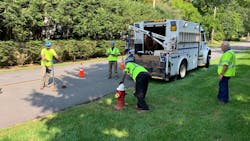New Jersey American Water pilots new pressure monitoring technology in existing hydrant
NEW JERSEY -- New Jersey American Water is the largest investor-owned water utility in the state of New Jersey, servicing approximately 2.8 million people in 192 communities across 18 counties. The utility proactively replaces aging pipes, valves, service lines and other parts of its 10,000-mile network of water and sewer mains. The company continually seeks opportunities to monitor its distribution network and obtain infrastructure data to enhance water quality, service reliability, and fire protection for the communities served.
To enhance its ability to monitor pressure, New Jersey American Water participated in a pilot program to test the capabilities of the new Sentryx software enabled Super Centurion fire hydrant in August 2020. A site on Old Chester Road was chosen to measure and monitor pressure in Chester Township, where modulation of pressure was occurring at a pressure reducing valve (PRV) in the system.
For American water, it was important to understand the near real-time pressure data in the Old Chester Road area to understand daily changes. This monitoring effort would help accomplish its overall goal of minimizing pressure at night, but not allow the pressure to drop below 30 PSI during the daytime.
Previously, the utility monitored pressure at this location with a pressure recording unit. However, the unit could only be used above freezing temperatures, so a pressurized fire hydrant barrel was required and data was not captured during the winter months when pressuring the hydrant was not possible. The team had become aware of the new hydrant retrofit kit, featuring pressure monitoring, and felt it was a good solution for monitoring pressure on a year-round long basis. Since the sensor is located in the bottom of the hydrant below the valve, pressure data can be recorded year-round with the Sentryx Water Intelligence Platform.
For this project, New Jersey American Water retrofitted an existing 2010 MuellerÒ Super Centurion hydrant with the pressure monitoring kit, placing new technology into their system while avoiding the need to dig. The pressure sensor is protected, enshrouded within the lower stem, and is able to capture data (with the main valve closed) from the water in the hydrant shoe located at this point in the company’s network. The data is transmitted from within the hydrant to the scalable, web based Sentryx Water Intelligence Platform, providing accurate pressure information from the distribution network.
New Jersey American Water’s installation of the retrofit kit went smoothly. To allow time for the crew to learn the installation steps, the company budgeted two hours to complete the first installation, however, they believe future installs will take one hour or less to complete. Once the kit was in place, pressure readings were available almost immediately on the platform. When asked how the kit installation differed from a regular hydrant install, Ron Oppenheimer, Project Manager, Operations, stated, “It was really no different than replacing the main washer or stem on a Mueller hydrant, the only exception being the installation of the new stem and bonnet with the technology.”
Donald C. Shields, Vice President and Director of Engineering noted, “What’s nice about this is that it fits with a lot of installed assets that we already have and the integration with existing technology is an easy fit for us.”
While the New Jersey American Water pilot program is still in the evaluation stage, the data received so far from the location on Old Chester Road has been valuable to the utility.
“Sometimes data can be overwhelming, but in cases like this where you have an abundance of data, it can help fill in the questions to viability of additional projects to help with managing your water systems. Water loss or nonrevenue water is always a concern, so if we can lower pressure during off-peak periods, it’s one way to reduce our water losses,” said Russell G. Titus, Sr. Project Manager Engineering.
Shields concluded, “We think that there is a need for this out there… we are optimistic that the technology is really going to help us with managing pressure transients, pressure issues, and water loss management. It’s another nice tool to have in the tool kit.”
Author: Dave Johnston, Director of Smart Infrastructure, Mueller




